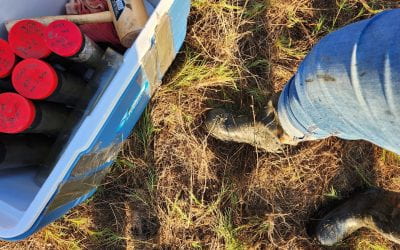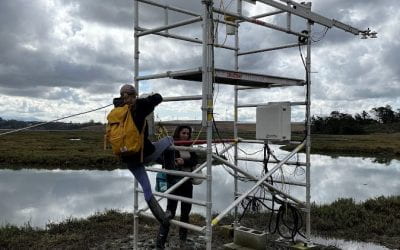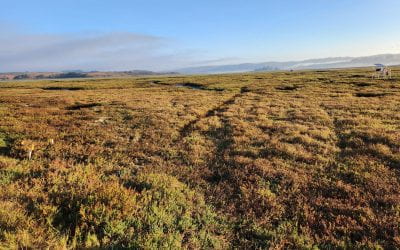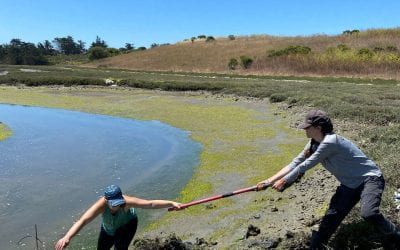One area of active research for the Paytan Lab group is the Elkhorn Slough National Estuarine Research Reserve. The approximately 1,700 acres that comprise the reserve include salt marsh, mud flat, freshwater pond, oak woodland, and grassland habitats.
Elkhorn Slough is a seven-mile arm of the Monterey Bay located half way between the cities of Santa Cruz and Monterey. This arm has a bend in it as it extends inland, and at the “elbow” lies the reserve. The reserve is owned and managed by the California Department of Fish and Wildlife (CDFW) and it operates in partnership with the federal National Oceanic and Atmospheric Administration (NOAA) and the local, non-profit Elkhorn Slough Foundation. It is one of 22 national estuarine research reserves around the country that serve as representative estuaries for research, education and habitat stewardship. It was designated as an ecological reserve by the Fish and Game Commission in 1980.
Sulfur
Sulfur is an essential element in biogeochemical cycling in wetland ecosystems. It plays a role in crucial processes in the ecosystem such as acidification, redox reactions, and sulfate reduction. These processes affect the chemistry of wetland waters and are linked with the carbon biogeochemical cycle. We are using isotope geochemistry and ion chromatography to investigate sulfur dynamics in various wetland conditions in the Elkhorn Slough. Research led by Natalie Hermosillo.
Wetland Eddy Covariance
The wetlands in Elkhorn Slough are home to many species of wildlife, filter pollutants from water, and can store lots of Carbon in their soils, often referred to as blue carbon. 1,000 acres of Elkhorn Slough’s salt marshes have been lost over the past 150 years because of draining and diking for agricultural use. The Elkhorn Slough National Estuarine Reserve is working to restore lost wetlands and researchers from the Paytan Lab at UCSC are collaborating with the reserve on a new project measuring greenhouse gasses at restored and undisturbed marshes in the Slough.
When drained wetlands are re-flooded during restoration, the soil can sometimes release greenhouse gasses like methane to the atmosphere. Scientists have to measure the carbon balance of wetlands to make sure carbon dioxide stored in the soil is not offset by methane released to the atmosphere. Reserve staff and the Paytan Lab Slough team are measuring greenhouse gasses in 5 wetlands in the Slough with systems called Eddy Covariance Flux Towers. We are directly measuring gas fluxes in Slough salt marshes by mounting gas and wind sensors on towers that stand above the vegetation. These flux towers also have sensors to monitor water quality, soil temperature, and other environmental variables so we can learn even more about the salt marshes and what drives gas exchange.
Each marsh where researchers are measuring greenhouse gas flux has a unique ecological history. One goal of this research study is to examine how greenhouse gas flux might vary across different types of wetlands. We are comparing results from restored vs. undisturbed wetlands and tidally restricted vs tidally unrestricted wetlands to see how management techniques affect greenhouse gas emission and carbon storage. See the map and site descriptions below to learn more about the marshes where we are working.
Porter Marsh – A tidally restricted and diked salt marsh. The area is dotted with berms, islands, and mudflats, and is cut by a creek that floods seasonally.
North Marsh – Currently under restoration, this marsh is diked and tidally restricted with levees dating from 1903-1980. Restoration will improve tidal exchange and vegetation presence.
Yampah Marsh – An undisturbed salt marsh made up of islands with dense pickleweed cut by tidal channels. The marsh floods daily with the tidal cycle and is home to a variety of wildlife.
Hester Marsh – A salt marsh restored in 2018 by adding soil to raise 61 acres of former tidal marsh to an elevation that allows native plants to return and keep pace with projected sea level rise.
Moro Cojo Marsh – An expansive tidal marsh made up of muddy banks, shallow brackish water, and mudflats that support a wide variety of plant and animal life.
Check out the Elkhorn Slough Visitor Center and stop by the Flux Tower display that Gracie set up!
Slough Research Team












